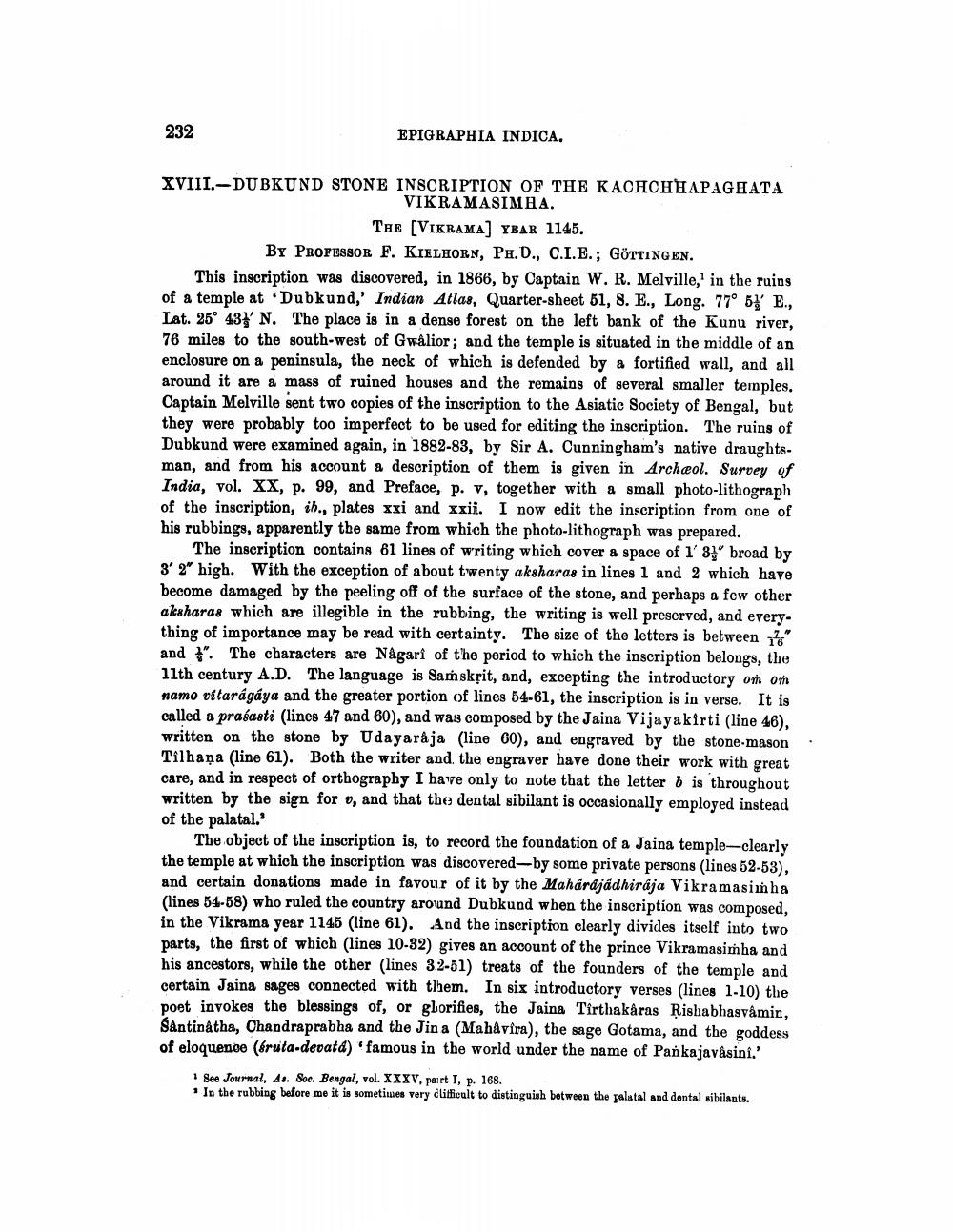________________
232
EPIGRAPHIA INDICA.
XVIII.-DUBKUND STONE INSCRIPTION OF THE KACHCHHAPAGHATA
VIKRAMASIMHA.
THE (VIKRAMA] YEAR 1145. BY PROFESSOR F. KIELHORN, Ph.D., C.I.E.; GÖTTINGEN. This inscription was discovered, in 1866, by Captain W. R. Melville,' in the ruins of a temple at Dubkund,' Indian Atlas, Quarter-sheet 51, S. E., Long. 77° 54' E., Lat. 25° 43' N. The place is in a dense forest on the left bank of the Kunu river, 76 miles to the south-west of Gwalior; and the temple is situated in the middle of an enclosure on a peninsula, the neck of which is defended by a fortified wall, and all around it are a mass of ruined houses and the remains of several smaller temples, Captain Melville sent two copies of the inscription to the Asiatic Society of Bengal, but they were probably too imperfect to be used for editing the inscription. The ruins of Dubkund were examined again, in 1882-83, by Sir A. Cunningham's native draughtsman, and from his account a description of them is given in Archæol. Survey of India, vol. XX, p. 99, and Preface, p. v, together with a small photo-lithograph of the inscription, ib., plates xxi and xxii. I now edit the inscription from one of his rubbings, apparently the same from which the photo-lithograph was prepared.
The inscription contains 61 lines of writing which cover & space of 1' 3" broad by 32 high. With the exception of about twenty aksharas in lines 1 and 2 which have become damaged by the peeling off of the surface of the stone, and perhaps a few other aksharas which are illegible in the rubbing, the writing is well preserved, and everything of importance may be read with certainty. The size of the letters is between 7" and *". The characters are Nagari of the period to which the inscription belongs, the 11th century A.D. The language is Saṁskřit, and, excepting the introductory or on namo vitarágáya and the greater portion of lines 54-61, the inscription is in verse. It is called a prasasti (lines 47 and 60), and was composed by the Jaina Vijayakirti (line 46), written on the stone by Udayaraja (line 60), and engraved by the stone-mason. Tilhaņa (line 61). Both the writer and the engraver have done their work with great care, and in respect of orthography I have only to note that the letter b is throughout written by the sign for o, and that the dental sibilant is occasionally employed instead of the palatal.'
The object of the inscription is, to record the foundation of a Jaina temple-clearly the temple at which the inscription was discovered-by some private persons (lines 52-53), and certain donations made in favour of it by the Mahárdjádhiraja Vikramasinha (lines 54-58) who ruled the country around Dubkund when the inscription was composed, in the Vikrama year 1145 (line 61). And the inscription clearly divides itself into two parts, the first of which (lines 10-32) gives an account of the prince Vikramasimha and his ancestors, while the other (lines 32-51) treats of the founders of the temple and certain Jaina sages connected with them. In six introductory verses (lines 1-10) the poet invokes the blessings of, or glorifies, the Jaina Tirthakaras Rishabhasvamin, Santinátha, Chandraprabha and the Jina (Mahavfra), the sage Gotama, and the goddess of eloquenoe (fruta-devatd) 'famous in the world under the name of Pankajavâsini.'
* See Journal, 4.. Soc. Bengal, vol. XXXV. part I, p. 168. 1 In the rubbing before me it is sometimes very clifficult to distinguish between the palatal and dental sibilants.




